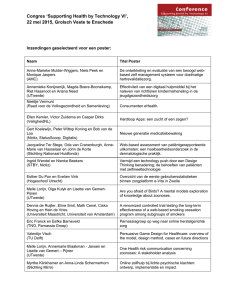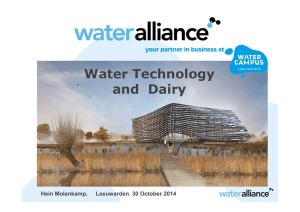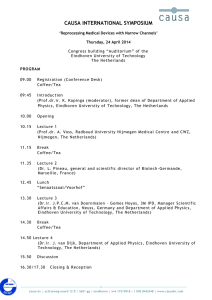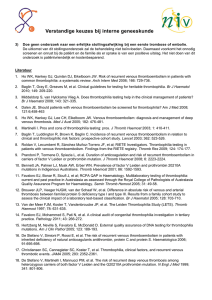Untitled
advertisement
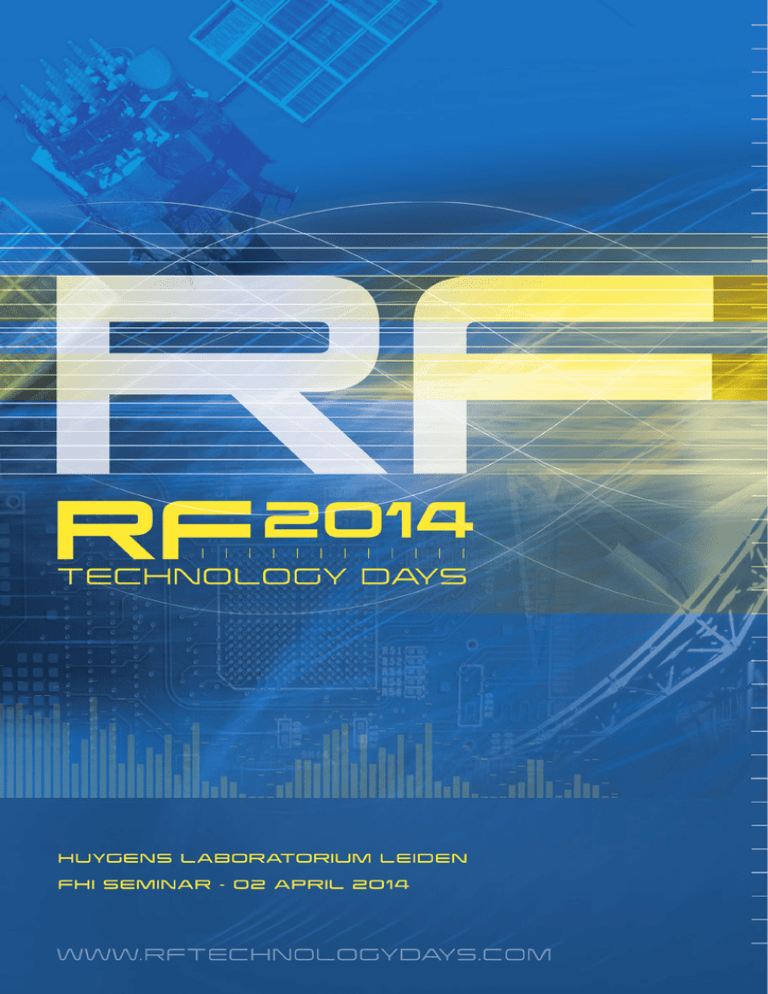
RF 2014 TECHNOLOGY DAYS The RF Technology Day in the Netherlands takes place on the 2nd of April. The goal of the seminar is to show the diversity of applications, innovations and knowledge in radio frequency technology. The event is organised by trade association FHI and twenty participating companies. 2 april 2014 This year’s topic is ‘Trends in Radio Frequency’, the participants will show which new technologies have come available, which applications have come available and which new technologies will come next. Knowledge and practical developments are central in both the plenary and parallel sessions of the seminar. The entire range of the market, appliers, developers, suppliers and institutes, are brought together at the RF Technology Day. Vision, experience and capabilities will be shared with colleagues. A visit is crucial for: • Development engineers • System architecs • Hardware engineers • Technical and R&D management • Test engineers • Project managers • General managers • Professors • Employees of knowledge institutes Visitors will receive specific, technological information and you will be shown the newest technologic possibilities. The plenary sessions focus on the combination of knowledge with practical applications. Parallel sessions may focus on components, development and test- & measurement. Furthermore, the Huygens Laboratory provides the possibility of a tour through the lab where they will show several test setups. Twenty exhibitors will show the latest developments in radio frequency technology. The RF Technology Day also offers a great opportunity for networking and finding contacts to improve your applications and your knowlegde. For a free visit to the RF Technology Day Netherlands, please register at WWW.RFTECHNOLOGYDAYS.COM Huygens Laboratorium Leiden Target industries are: • Data-/ Telecom • Developers • Medical technology • Aerospace & defence • Industrial automation • Agricultural industry • Research institutes • Education / Universities • Energy suppliers RF 2014 TECHNOLOGY DAYS PROGRAM 1/3 09.30 - 09.55 Gebruik van HF technologie bij Elektron Paramagnetische Resonantie (EPR) EPR wordt gebruikt bij onderzoek van materialen en (fysische, chemische of biologische) processen waarbij het magnetisch dipoolmoment van elektronen een rol speelt. De aanwezigheid van deze elektronen wordt waargenomen doordat zij in een statisch magneetveld in resonantie worden gebracht met microgolven. Voor een goede analyse is een hoge resolutie nodig. Deze kan worden bereikt door de combinatie van een hoog magneetveld en een hoge microgolffrequentie. Deze presentatie behandelt een tweetal EPR-spectrometers, respectievelijk werkend met een frequentie van 95 GHz ( ~ 3mm) en 275 GHz ( ~ 1 mm). Het 95 GHz-systeem is gebouwd met golfgeleiders; bij 275 GHz wordt grotendeels een zgn. pseudo-optisch systeem toegepast. Beide systemen kunnen zowel met continue als gepulste microgolven worden gebruikt. Enkele speciale aspecten van de systeemopbouw zullen worden toegelicht. Jos Disselhorst en Dr. Huib Blok, Huygens Laboratorium, Universiteit Leiden 10.00 - 10.30 Slimme radio, een frequentieruimte-multiplier? Slimme radio oftewel cognitieve radio zoekt zelf zijn tijdelijke plek in het frequentiespectrum. En wel op een zodanige manier dat de reeds aanwezige gebruikers van die frequenties daar geen hinder van ondervinden. In theorie een prachtige manier om zonder storing dezelfde frequentieruimte beschikbaar te stellen voor meerdere gebruikers. Een echte frequentieruimte-multiplier. John Derksen, Hoofd Spectrummanagement van Agentschap Telecom, gaat in op de meest recente ontwikkelingen rond cognitieve radio en op de vraag onder welke voorwaarden slimme radio zijn belofte kan waarmaken. Voordat het zover is, zijn er nogal wat uitdagingen te overwinnen. Hoe komen we uit de huidige kip-ei-situatie? Geldt hier de tragedie van de commons ook? Welke technische uitdagingen zijn er nog op te lossen? En... wie durft? John Derksen, Agentschap Telecom 10.30 - 11.00 Coffee break & transition to parallel sessions 11.00 - 11.25 Experience with RF simulations in antenna development Grafeen: dé kandidaat voor de nieuwe generatie (HF-)elektronica For most of us antenna technology is a magical realm. In this contribution a recent development in the field of antenna technology is presented. The presentation gives insights in the design goals that were to be achieved and in the problems that had to be overcome. During the presentation it will be shown how the RF behaviour of the new antenna was simulated and how these simulations relate to the actual end results. Patrick Dijkstra, DARE!! Development Grafeen wordt algemeen gezien als hét materiaal voor de toekomstige elektronica (sneller en zuiniger). Wat is grafeen en wat kan het (met name op HF-gebied)? Welke hobbels moeten genomen worden voordat grafeen op grote schaal in elektronica kan worden toegepast? Met ons fundamentele onderzoek, waarbij gebruik wordt gemaakt van een unieke, zelfgebouwde microscoop (een variabele temperaturen STM) proberen we te begrijpen hoe perfect grafeen gegroeid kan worden. Dirk W. van Baarle, Universiteit Leiden Miniature Ceramic Filters One RF Measurement Science for Multiple Instrument Form Factors F technology applied in space and R ground systems Determining which instrument form factor is best suited for testing needs is dependent upon several qualities: speed, performance, cost, footprint, user interface, and more. There is not one of these form factors which is the best, so users need to choose based on the most important needs for their stage of the product lifecycle. By sharing the same measurement science between these form factors, engineers can now create synergies instead of creating inefficiencies. Gustaaf Sutorius, Agilent Technologies on behalf of ACAL BFi SSBV Space & Ground Systems provides innovative space and ground system solutions. The ground based activities include Earth Observation and TTC modems. In the space segment SSBV is involved in the development of instruments and electronics for a new generation of smallsat SAR imaging radar. RF technology plays a crucial role in the front-ends of all of these systems, which will be elaborated in the presentation. Laurens Bierens, SSBV Space & Ground Systems on behalf of Electro Rent Europe 11.30 - 11.55 This presentation describes the design and manufacture of surface mount miniaturised filters offering performances up to 20GHz+. The process of "prototyping before manufacture" will be described, based on a realisation on high dielectric constant ceramic substrate using a 2.5D solver together with full characterisation of the x,y and z components of dielectric constants. Manufacturers of these filters use Industry standard MIC processing techniques. Gavin Ripley, BSC Filters on behalf of Heynen Passive Intermodulation (PIM), an RF interference, challenging the radio access network performance Passive Intermodulation (PIM) is not a new phenomenon. With multiple transmit carriers and the use of multi-technology sites (GSM, UMTS, CDMA and LTE) by several operators, PIM issues are getting more serious and more complex. This presentation gives a full overview off the fundamentals of intermodulation, problems caused by Passive Intermodulation solutions to reduce PIM and new testing techniques to improve the radio access network performance. Johan Nordhall, Kaelus namens Livingston RF 2014 TECHNOLOGY DAYS PROGRAM 2/3 12.00 - 12.25 Next generation High Reliability, Low Loss PCB substrates Testing & Troubleshooting for WiFi 802.11 embedded design A user introduction to GPS theory and simulation The paper will cover the next generation of low loss PCB substrates, focussing on Isola's I-TERA® MT, which exhibits significant cost of ownership advantages over traditional PTFE and/or ceramic filled materials. The electrical, thermal and mechanical properties will be described along with the processing and other advantages over traditional solutions. Alun Morgan, Isola Group Europe on behalf of Eurocircuits Millions of IEEE 802.11 devices are in use and they operate in the same frequency bands. This makes the need for their coexistence critical. Testing a new chipset, designing a new WLAN module, or integrating a module into your latest design, requires testing interoperability. This presentation provides an overview for each of the 802.11 standards, including 802.11/ac 160MHz@5GHz, PHY layer characteristics and testing requirements. Bernd Wessling, Tektronix on behalf of C.N. Rood A short discussion about how the global positioning system works, showing some of the complex theory behind getting a GPS fix on a receiver, and an introduction and demonstration of some of the latest hand held equipment that can be used for multi-satellite GPS simulation (GPSG-1000). Barry Hack, Aeroflex UK on behalf of T&M Systems B.V. Vijf gouden tips voor de perfecte coaxverbinding TETRA Site and Coverage acceptance measurements Tijdens de presentatie nemen wij u mee terug naar de basis van de coaxverbinding en bijhorende techniek. Vanuit daar gaan wij systematisch op weg naar een perfecte coaxverbinding. U zult persoonlijk ervaren welke valkuilen en uitdagingen u hierbij kunt verwachten. Uw keuze voor de juiste kabel en connectoren is hierbij van cruciaal belang. Daarnaast spelen de toepassing, de omgevingsconditie en bijhorende afschermingsmethode ook mee in uw beslissingstraject. Léon-Marc Roefs, Simac Electronics TETRA is the most successful mission critical communication voice and narrowband data mobile standard in the global PMR market segment at the moment. Anritsu will present latest news about Over-the-Air (OTA) measurements for modulation quality and cell parameter measurements. Along with this topic GPS aided RSSI and BER based radio coverage measurements for buildings, tunnels and free space scenarios are presented. Ferdinand Gerhardes, Anritsu GmbH Harmful RF discharge in highpower vacuum systems: what is the Multipactor Effect High-Speed EMI testing with FFT based real-time analyzers and oscilloscopes The Multipactor phenomenon is a harmful effect since it degrades the transmitted signal, it can damage and even destroy RF devices. The design of Multipactor free components is critical for industries like Space, Vacuum Electronics, Radar, Satellite Systems and Particle Accelerators. This lecture introduces the basics of Multipactor and it’s dependence on several factors. The fundamentals of Multipactor testing will also be outlined. Dr. Sergio Anza, Aurora Software and Testing on behalf of AR Benelux Door het gebruik van 2 technieken, m.n. FFT én Time Domain Scan worden meettijden drastisch verkort ten opzichte van traditionele EMI ontvangers. Dit levert EMC laboratoria een sterk verhoogde efficiëntie op en daardoor een verlaging van de kosten voor EMC approval. Deze FFT techniek wordt eveneens gebruikt in high-speed oscilloscopen bij productontwikkeling. Deze presentatie geeft een overzicht van de theorie en techniek achter het real-time EMI testen. Jos Westhof-Jacobs, Rohde & Schwarz 12.30 - 13.30 Lunch break 13.30 - 13.55 Fast and Accurate RF component characterization enabled by FPGA technology To address the needs for increased performance and complexity, RF instruments leverage field-programmable gate arrays (FPGAs). These FPGAs are typically closed with fixed personalities designed for specific purposes and allow little customization. RF instrumentation with user-programmable FPGAs can bring significant speed and flexibility advantages to users as will be highlighted in a RF component characterization application. Guillaume Pailloncy, National Instruments 14.00 - 14.25 Prediction of Co-site interference in complex RF environments Predicting cosite interference and analyze multi-antenna platforms in complex RF environments such as commercial aircrafts, UAVs or ships can be a challenging task. This talk will demonstrate how software tools such as CST STUDIO SUITE® and EMIT can help engineers to analyze and mitigate interference effects. A complete workflow starting from the simulation of the antenna coupling to the system co-site interference of the RF-Systems will be presented. Dr. Frank Demming-Janssen, CST AG Germany on behalf of Hi-Tech RF & Microwave solutions 14.30 - 15.00 Coffee break RF 2014 TECHNOLOGY DAYS PROGRAM 3/3 15.00 - 15.25 15.30 - 16.00 Throughput test method for MIMO Radios with Over the Air coupling Small temperature sensor using mm-wave data and power transfer The challenge of Radiated testing of LTEAdvanced and IEEE 802.11ac devices. Network Equipment manufacturers and operators need to test the integrated design of set-topboxes, access points, clients including the MIMO antenna propagation, in a repeatable way. This is only possible in a radiated setup with a controlled multipath emulation. Recent developments are making this test setup available on every engineers desktop. Fanny Mlinarski, octoScope namens Tucana Many sensor applications require many small wireless sensors, preferably combined with low cost and long battery life. The Centre for Wireless Technology has developed a prototype of a very small (0.2mm^3) batteryless temperature sensor. Both data communication and power transfer are achieved through a mm-wave (60GHz) radio connection. In this presentation, the system design for this sensor as well as some critical aspects of the circuit implementation will be discussed. Hao Gao, TU/e Electrical fast transient / Burst immunity test according new IEC 61000-4-4 Edition 3 The fast transient test (EFT/burst) is a test with burst consisting of a number of fast transients, coupled into power, control and signal lines of electronic equipment. Significant for this test is the high amplitude, the short rise time, the high repetition frequency and the low energy of the transients. The new Edition 3 (2012) specifies new capacitive coupling clamp and calibration routines. Frank Niechcial, EM TEST GmbH Application of high power microwaves for the stabilisation of nuclear fusion plasmas In ITER, the nuclear fusion reactor that is presently built in France, hot plasma will be confined and brought to conditions that nuclear fusion occurs. However, the plasma is intrinsically unstable, which leads to an unwanted decrease of the fusion figure of merit. An active control system will be presented, based on low-power microwave sensing and high-power microwave actuation of the plasma, with the view to locate and kill the unstable modes in the plasma. M. de Baar et al. FOM institute Differ and TU/e 16.00 - 17.00 Drinks & networking 16.00 - 17.00 Rondleidingen en Demonstraties Na afloop van het lezingenprogramma bestaat de mogelijkheid om een rondleiding door het Huygens Laboratorium te volgen. Tijdens deze rondleiding wordt een viertal demonstraties gegeven. Het aantal plaatsen is beperkt, meld u voor de rondleiding met demonstraties aan via de website. Demo 1 95GHz EPR Spectrometer De opstelling van de 95 GHz spectrometer met de aansluiting naar de trilholte in de magneet. Het systeem is geheel met golfpijpen uitgevoerd. Om verlies in transmissie te beperken wordt voor het deel naar de trilholte “oversized” golfpijp gebruikt. Demo 2 275GHz EPR Spectrometer De pseudo-optische componenten zijn geplaatst boven een supergeleidende magneet die het hoge magneetveld (tot 10 T) genereert. De magneet wordt gekoeld met vloeibaar Helium. In de kern van deze magneet bevindt zich een trilholte met daarin het te onderzoeken preparaat. Demo 3 MRI Scanner for Nanoscale Samples (MRI-AFM) Magnetic Resonance Imaging by Atomic Force Microscopy (MRI-AFM) is a promising new technique to resolve the internal atomic structure of biological nanostructures such as virus particles and proteins. MRI-AFM relies on the detection of the force between a small number of nuclear spins and a micron-sized magnet that is attached to a soft cantilever. By exciting the spins with electromagnetic pulses, we can alternate the force on the magnet, which results in an oscillation of the cantilever. By monitoring the cantilever oscillations while scanning it over the sample, we can map the density of spins in the sample in three dimensions. Demo 4 Making future electronics enter reality: Graphene Graphene-based electronics are expected to make devices faster (up to THz-regime), smaller (nm-sized) and more efficient. We try to understand and optimize the graphene synthesis process by real-time microscopy techniques (STM) in order to finally produce a perfect resource for future electronics. For a free visit to the RF Technology Day Netherlands, please register at WWW.RFTECHNOLOGYDAYS.COM RF 2014 TECHNOLOGY DAYS EXHIBITORS ar benelux www.acalbfi.com www.anritsu.com www.arbenelux.com www.capable.nl www.cnrood.nl www.dare.nl www.eemc.nl www.electrorent-europe.com www.emtest.de www.eurocircuits.com www.heynen.nl www.hftechnology.nl www.hitechbv.nl www.ingun.com www.livingstonrental.nl www.ni.com www.rohde-schwarz.com www.simacelectronics.nl www.tmsystems.nl www.tucana.com ONDERSTEUNENDE ORGANISATIES www.etotaal.nl www.engineersonline.nl www.engineersonline.nl www.tue.nl www.veron.nl www.kivi.nl www.leidenuniv.nl
